Have you ever seen this splendid flower in our gardens? It is rare there and yet it is not really exotic since it comes from Burma. It was discovered and described in this country in 1829 by the surgeon botanist Nathaniel Wallich. He named it in honor of Lady Amherst, a great collector of plants and wife of the Governor General of the English Indies. A rare thing, this tree which belongs to the Fabaceae family has only one genus, one species and has never had synonyms.
It must be said that the tree is rare even in Burma because it reproduces with difficulty; it fruits little and requires high atmospheric humidity with rich and well-drained soil. It is therefore only found cultivated in the gardens of Southeast Asia.
It is an evergreen tree about fifteen meters high. Its leaves are dark green, pinnate, and can reach 1 meter long. Like those of the Saraca that we know well in Laos, when they are young, they hang towards the ground in long tufts of several meters, supple and soft of a reddish pink. The inflorescences form long and hanging clusters composed of large irregular astonishing flowers; they have 5 petals, the 3 upper ones of the same length, red with a yellow spot, but the middle petal is much wider than the other two; the two lower petals, also red, are atrophied; hooked stamens emerge from this corolla. The fruit is an elongated trapezoid pod, it contains 5 or 6 flat seeds.
To name this plant, Lao and Thai use the name of Saraka: sok raya or sok samsouk. As for the English language, it pays homage to its country of origin, Burma.
L’avez-vous déjà vue cette fleur splendide dans nos jardins ? Elle y est rare et pourtant elle n’est pas vraiment exotique puisqu’elle vient de Birmanie. Elle a été découverte et décrite dans ce pays en 1829 par le chirurgien botaniste Nathaniel Wallich. Il l’a nommée en l’honneur de lady Amherst, grande collectionneuse de plantes et épouse du gouverneur général des Indes anglaises. Chose rare, cet arbre qui appartient à la famille des Fabacées ne compte qu’un seul genre, une seule espèce et n’a jamais eu de synonymes.
Il faut dire que l’arbre est rare même en Birmanie car il se reproduit difficilement; il fructifie peu et exige une humidité atmosphérique élevée avec un sol riche et bien drainé. On ne le trouve donc que cultivé dans les jardins d’Asie du Sud-Est.
C’est un arbre toujours vert d’une quinzaine de mètres de haut. Ses feuilles sont vert foncé, pennées, pouvant atteindre 1 mètre de long. Comme celles des Saraca que l’on connaît bien au Laos, lorsqu’elles sont jeunes, elles pendent vers le sol en longues houppes de plusieurs mètres, souple et molles d’un rose rougeâtre. Les inflorescences forment des grappes longues et pendantes composées de grandes fleurs irrégulières étonnantes; elles ont 5 pétales, les 3 supérieurs de même longueur, rouge avec une tache jaune, mais le pétale du milieu est beaucoup plus large que les deux autres; les deux pétales inférieurs, rouges également, sont atrophiés; des étamines crochues émergent de cette corolle. Le fruit est une gousse en trapèze allongée, elle contient 5 ou 6 graines plates.
Pour nommer cette plante le lao et le thaï utilise le nom des Saraka : sok raya ou sok samsouk.
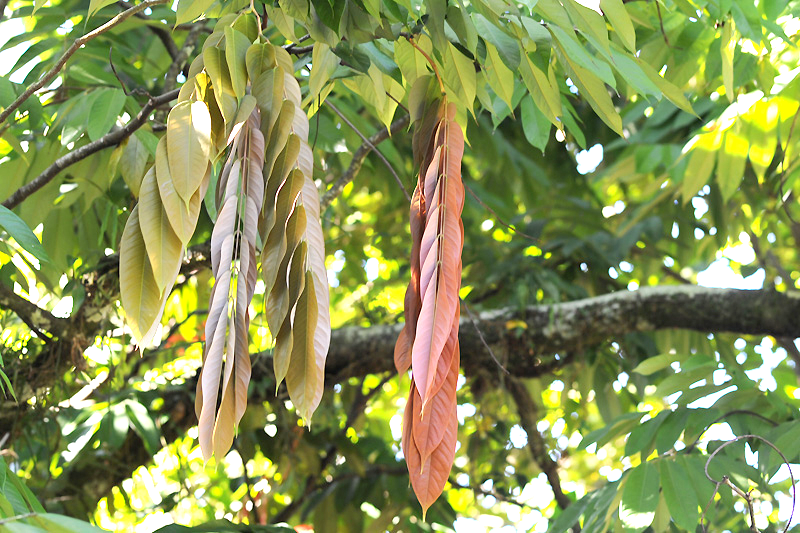
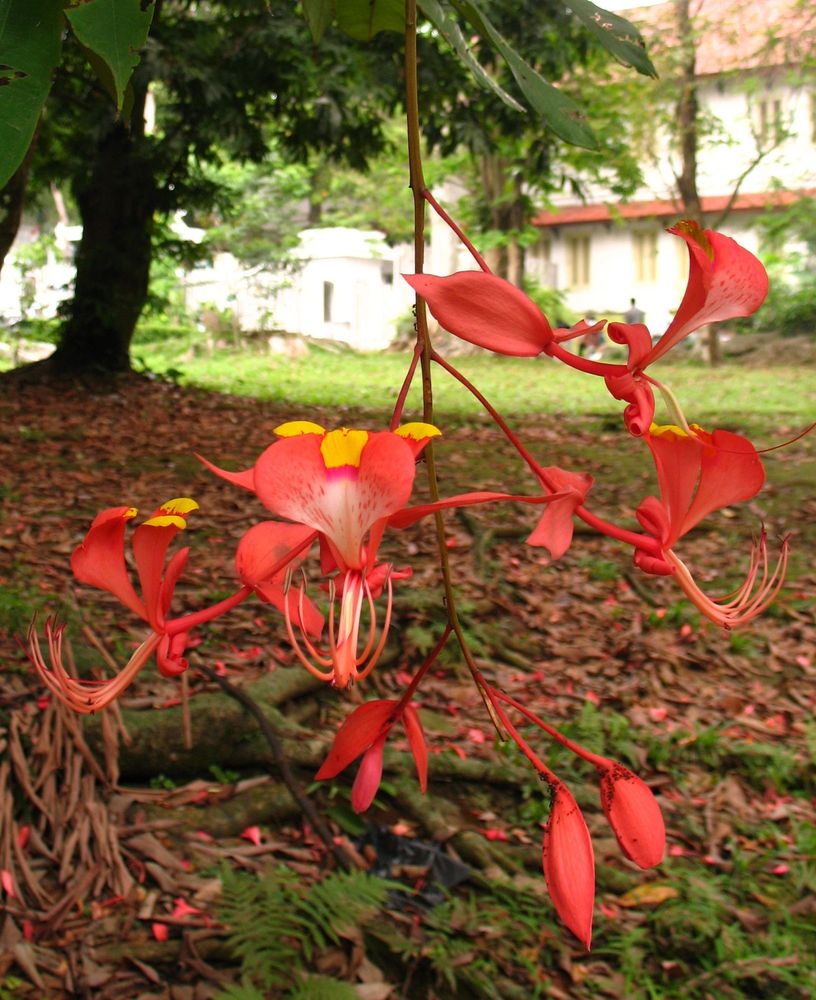
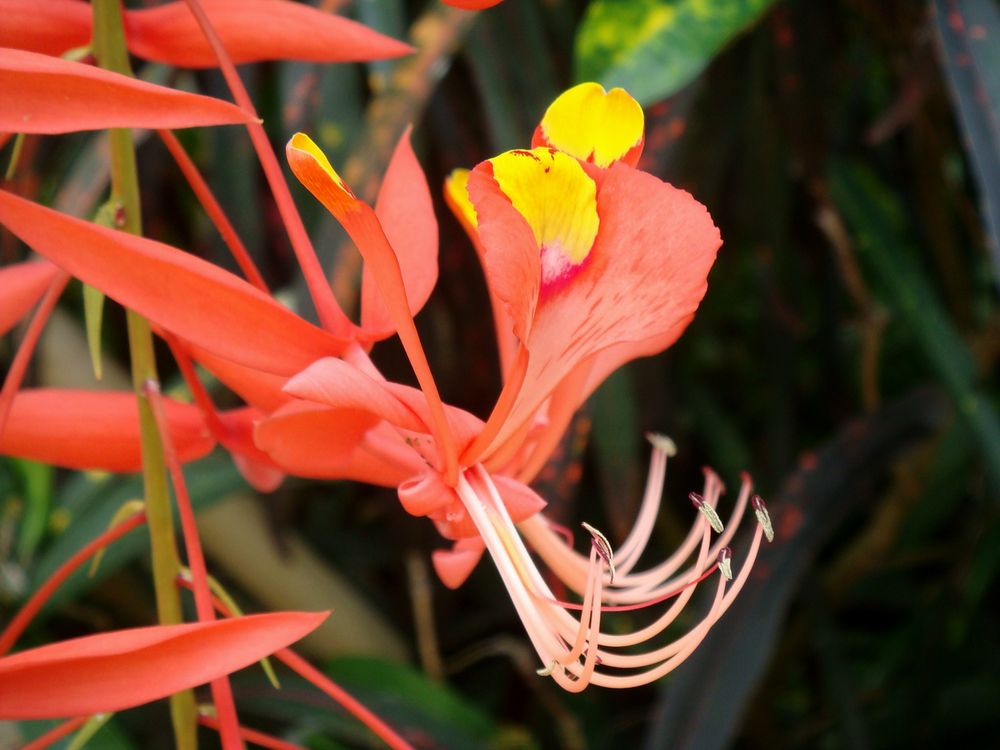
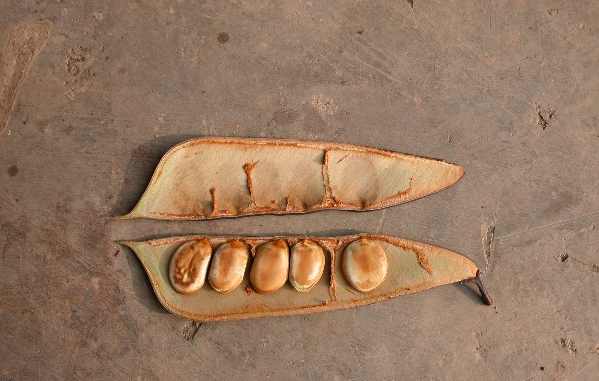
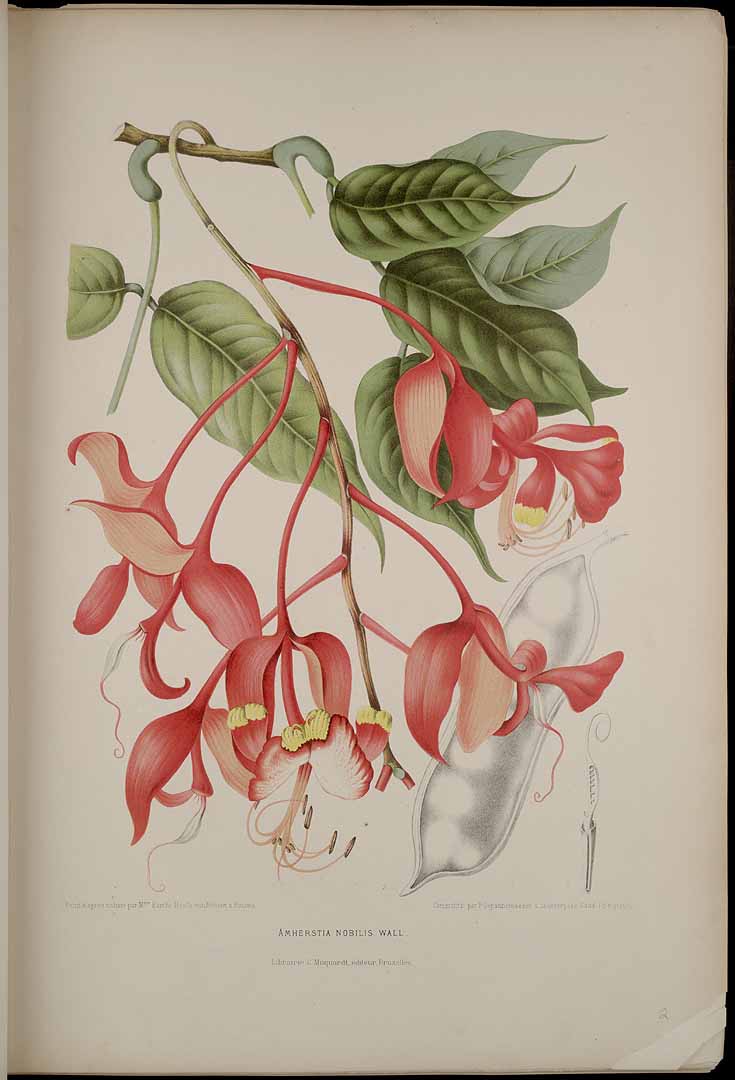
Have you ever seen this splendid flower in our gardens? It is rare there and yet it is not really exotic since it comes from Burma. It was discovered and described in this country in 1829 by the surgeon botanist Nathaniel Wallich. He named it in honor of Lady Amherst, a great collector of plants and wife of the Governor General of the English Indies. A rare thing, this tree which belongs to the Fabaceae family has only one genus, one species and has never had synonyms.
It must be said that the tree is rare even in Burma because it reproduces with difficulty; it fruits little and requires high atmospheric humidity with rich and well-drained soil. It is therefore only found cultivated in the gardens of Southeast Asia.
It is an evergreen tree about fifteen meters high. Its leaves are dark green, pinnate, and can reach 1 meter long. Like those of the Saraca that we know well in Laos, when they are young, they hang towards the ground in long tufts of several meters, supple and soft of a reddish pink. The inflorescences form long and hanging clusters composed of large irregular astonishing flowers; they have 5 petals, the 3 upper ones of the same length, red with a yellow spot, but the middle petal is much wider than the other two; the two lower petals, also red, are atrophied; hooked stamens emerge from this corolla. The fruit is an elongated trapezoid pod, it contains 5 or 6 flat seeds.
To name this plant, Lao and Thai use the name of Saraka: sok raya or sok samsouk. As for the English language, it pays homage to its country of origin, Burma.
L’avez-vous déjà vue cette fleur splendide dans nos jardins ? Elle y est rare et pourtant elle n’est pas vraiment exotique puisqu’elle vient de Birmanie. Elle a été découverte et décrite dans ce pays en 1829 par le chirurgien botaniste Nathaniel Wallich. Il l’a nommée en l’honneur de lady Amherst, grande collectionneuse de plantes et épouse du gouverneur général des Indes anglaises. Chose rare, cet arbre qui appartient à la famille des Fabacées ne compte qu’un seul genre, une seule espèce et n’a jamais eu de synonymes.
Il faut dire que l’arbre est rare même en Birmanie car il se reproduit difficilement; il fructifie peu et exige une humidité atmosphérique élevée avec un sol riche et bien drainé. On ne le trouve donc que cultivé dans les jardins d’Asie du Sud-Est.
C’est un arbre toujours vert d’une quinzaine de mètres de haut. Ses feuilles sont vert foncé, pennées, pouvant atteindre 1 mètre de long. Comme celles des Saraca que l’on connaît bien au Laos, lorsqu’elles sont jeunes, elles pendent vers le sol en longues houppes de plusieurs mètres, souple et molles d’un rose rougeâtre. Les inflorescences forment des grappes longues et pendantes composées de grandes fleurs irrégulières étonnantes; elles ont 5 pétales, les 3 supérieurs de même longueur, rouge avec une tache jaune, mais le pétale du milieu est beaucoup plus large que les deux autres; les deux pétales inférieurs, rouges également, sont atrophiés; des étamines crochues émergent de cette corolle. Le fruit est une gousse en trapèze allongée, elle contient 5 ou 6 graines plates.
Pour nommer cette plante le lao et le thaï utilise le nom des Saraka : sok raya ou sok samsouk.










Have you ever seen this splendid flower in our gardens? It is rare there and yet it is not really exotic since it comes from Burma. It was discovered and described in this country in 1829 by the surgeon botanist Nathaniel Wallich. He named it in honor of Lady Amherst, a great collector of plants and wife of the Governor General of the English Indies. A rare thing, this tree which belongs to the Fabaceae family has only one genus, one species and has never had synonyms.
It must be said that the tree is rare even in Burma because it reproduces with difficulty; it fruits little and requires high atmospheric humidity with rich and well-drained soil. It is therefore only found cultivated in the gardens of Southeast Asia.
It is an evergreen tree about fifteen meters high. Its leaves are dark green, pinnate, and can reach 1 meter long. Like those of the Saraca that we know well in Laos, when they are young, they hang towards the ground in long tufts of several meters, supple and soft of a reddish pink. The inflorescences form long and hanging clusters composed of large irregular astonishing flowers; they have 5 petals, the 3 upper ones of the same length, red with a yellow spot, but the middle petal is much wider than the other two; the two lower petals, also red, are atrophied; hooked stamens emerge from this corolla. The fruit is an elongated trapezoid pod, it contains 5 or 6 flat seeds.
To name this plant, Lao and Thai use the name of Saraka: sok raya or sok samsouk. As for the English language, it pays homage to its country of origin, Burma.
L’avez-vous déjà vue cette fleur splendide dans nos jardins ? Elle y est rare et pourtant elle n’est pas vraiment exotique puisqu’elle vient de Birmanie. Elle a été découverte et décrite dans ce pays en 1829 par le chirurgien botaniste Nathaniel Wallich. Il l’a nommée en l’honneur de lady Amherst, grande collectionneuse de plantes et épouse du gouverneur général des Indes anglaises. Chose rare, cet arbre qui appartient à la famille des Fabacées ne compte qu’un seul genre, une seule espèce et n’a jamais eu de synonymes.
Il faut dire que l’arbre est rare même en Birmanie car il se reproduit difficilement; il fructifie peu et exige une humidité atmosphérique élevée avec un sol riche et bien drainé. On ne le trouve donc que cultivé dans les jardins d’Asie du Sud-Est.
C’est un arbre toujours vert d’une quinzaine de mètres de haut. Ses feuilles sont vert foncé, pennées, pouvant atteindre 1 mètre de long. Comme celles des Saraca que l’on connaît bien au Laos, lorsqu’elles sont jeunes, elles pendent vers le sol en longues houppes de plusieurs mètres, souple et molles d’un rose rougeâtre. Les inflorescences forment des grappes longues et pendantes composées de grandes fleurs irrégulières étonnantes; elles ont 5 pétales, les 3 supérieurs de même longueur, rouge avec une tache jaune, mais le pétale du milieu est beaucoup plus large que les deux autres; les deux pétales inférieurs, rouges également, sont atrophiés; des étamines crochues émergent de cette corolle. Le fruit est une gousse en trapèze allongée, elle contient 5 ou 6 graines plates.
Pour nommer cette plante le lao et le thaï utilise le nom des Saraka : sok raya ou sok samsouk.


